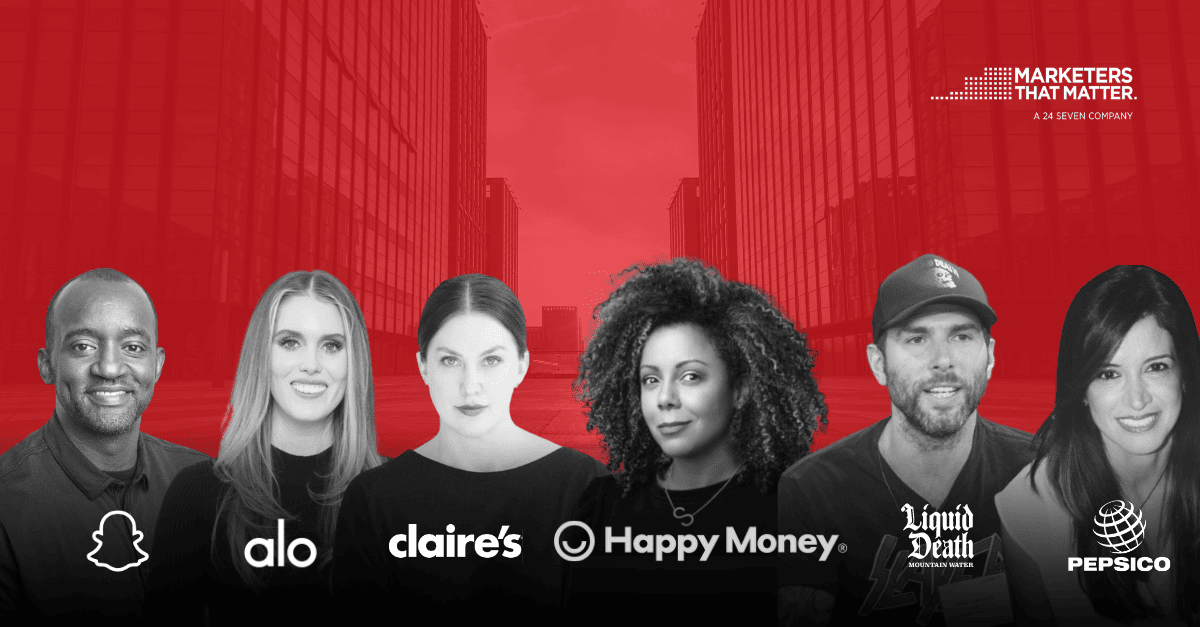During the Marketers That Matter Forum, hosted by Snap, Inc. at the LA Headquarters, six top marketing leaders from various industries talked about the “Now, Next, New” framework. They broke down what it is, how this tool can be applied to brands of all categories, and how to organize new technology, countless channel options, and innovative thinking into a strategy that works.
We heard from: Kenny Mitchell, the CMO of Snap, Inc., Sadira Furlow, the CMO of Happy Money, Fabiola Torres, the CMO of Pepsi Energy, Kristin Patrick, the EVP and CMO of Claire’s, Mike Cessario, the Co-Founder & CEO of Liquid Death Mountain Water, and Angelic Vendette, the CMO at Alo Yoga.
After an inspiring panel discussion, the room was divided into four groups and the speakers became peer coaches. Top marketers circled around whiteboards, popped off the lids to sharpie markers, and started forming a roadmap to help guide the marketing industry into the future.
In this article, you will find a compilation of all the insights gathered from the four breakout groups, in the form of a playbook for navigating the future of marketing.
Overview:
- What is the Now, Next, New Framework?
- Why the Now, Next, New Varies for Each Company
- Mastering Now
- Leaning into Next
- Daring to Be New
- Where Marketers Are Going
You Can Find the MTM Visionaries Podcast On Apple, Spotify, Amazon, and more!
What Is the Now, Next New Framework?
The “Now, Next, New” framework is a tool that solves a common problem many marketers face: how do you stay focused on what’s current but also think three steps ahead and be ready to jump when the market says, “jump!”?
The main benefit of this practice is that marketers can use it as a guide that helps teams stay oriented, reach company goals, cast a clear vision, and build a thorough case that makes stakeholders comfortable following along. Sadira Furlow described it as a flexible framework that can work no matter where you or your audience are at, help you steward investments, and keep your brand fresh.
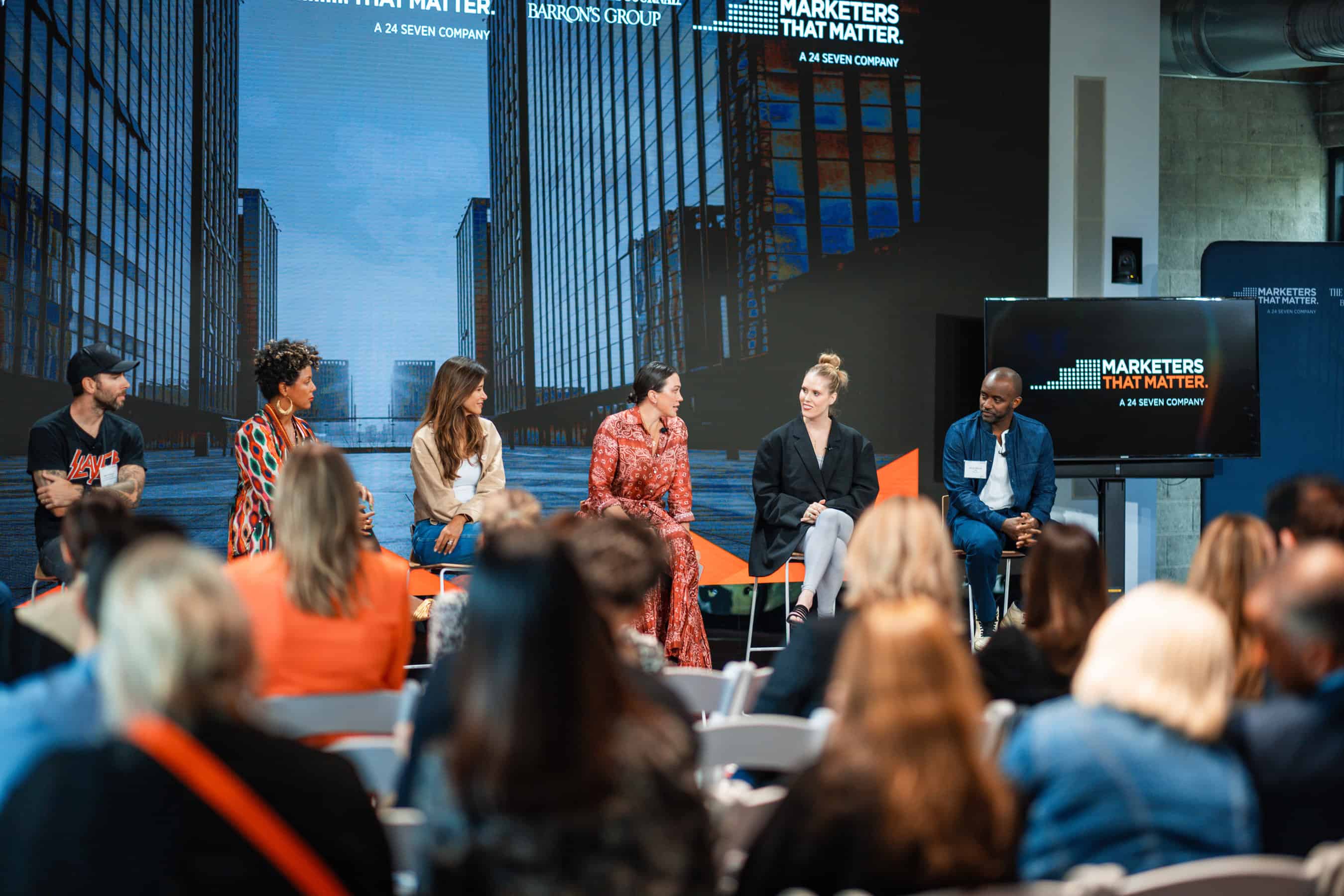
Now
The Now bucket includes initiatives that are predictable. They are core levers that help meet your objectives, which are measurable, familiar, and where your audience is most engaged. The Now is what your business is known for, what stabilizes your revenue, and what is driving most of your business.
Next
The Next bucket is where you are experimenting, testing, and learning. As you closely watch consumer trends, you might see your audience starting to shift there. You might not know how it fits into your plan, but it’s crucial to start investigating and putting out feelers. In other words, the Next is about throwing things into the matrix and hoping it sticks the landing – 99% of it usually doesn’t, but the 1% that does stick should get moved up into the Now category.
New
The New category includes untested strategies. Because it’s so new, it is hard to measure and predict where your efforts will lead and what the ROI will be. Even though you may have no idea where it might fit in your plan, your audience is into it, so it’s on your radar. New doesn’t always have to mean brand new technologies or channels. This can be an age-old marketing strategy, but entirely new to your brand.
Why the Now, Next, New Varies for Each Company
The Now, Next, New framework will vary depending on your category and industry. Variables like your business lifestyle, audience, segmentation, the recession, and supply chain also need to be considered.
For example, businesses like Nike and PepsiCo might be focused 70% in the Now. A company like Apple might have 50% in the Next and New. If you are a startup, you might focus 95% on the Now and split up the other five percent between Next and New, but again, these numbers are flexible.
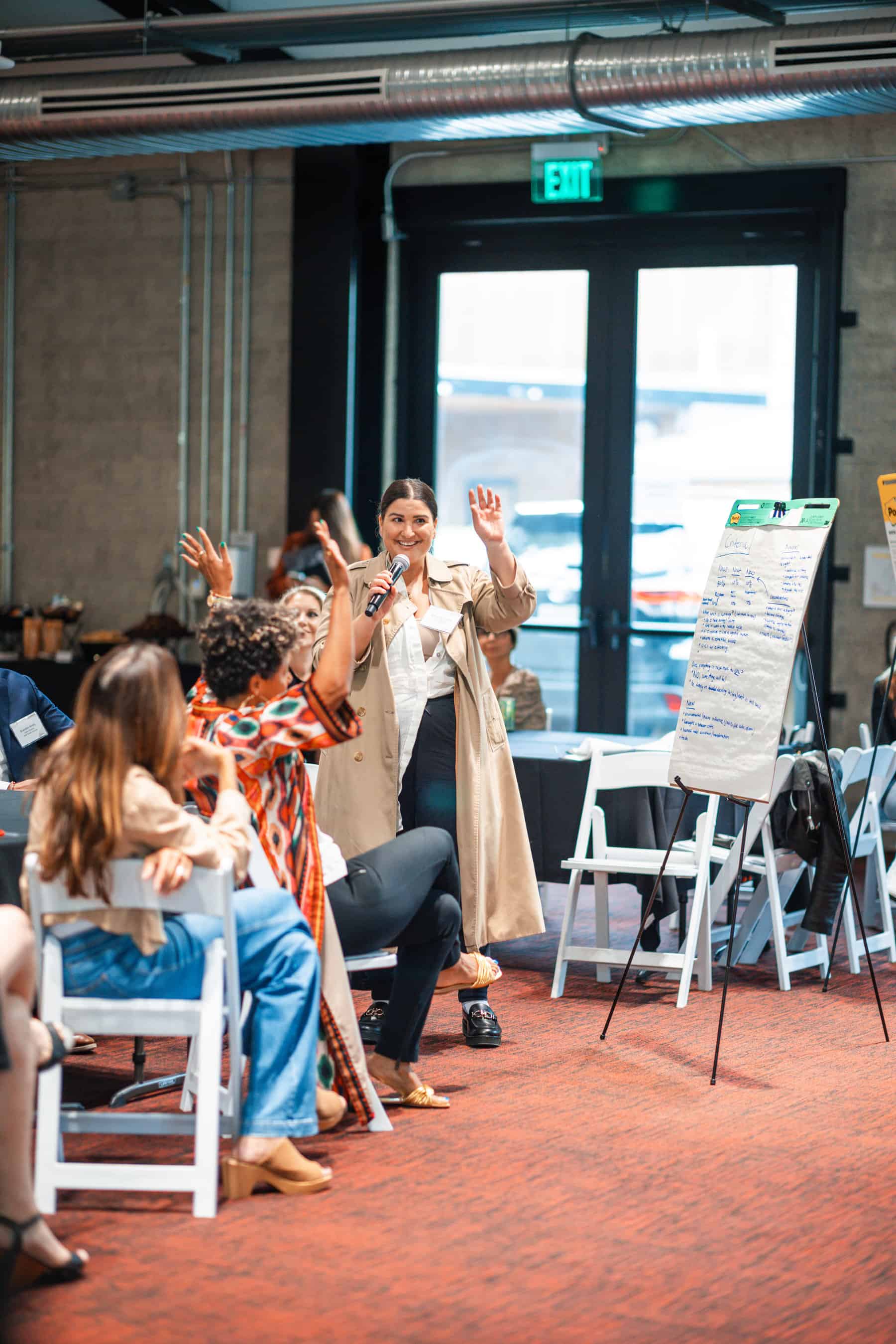
Sadira Furlow emphasized, “It’s important to note that the formula will be very fluid depending on how your categories and business are moving. With the pandemic, your business may have had E-Commerce in the New, and overnight, it needed it to shift to the Now.”
What we learned from an event like the pandemic is: start with a plan but continue to come back and adjust the formula based on the lifecycle of your business, where your consumers are going, and anything from the macro environment that may be disrupting or transforming your business.
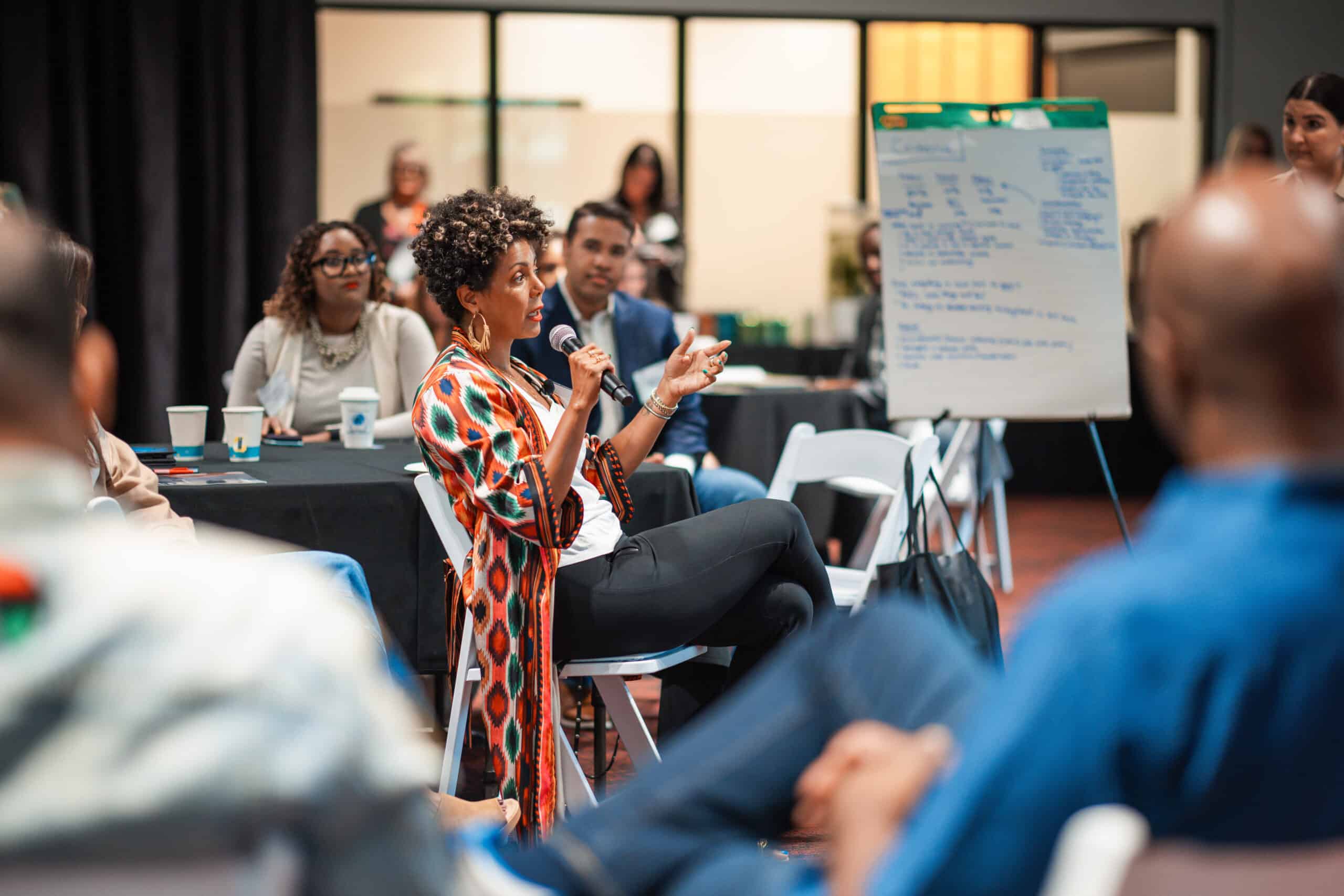
Sadira Furlow, CMO, Happy Money
Kenny Mitchell added, “Our numbers were 70% Now, 20% Next, and 10% New when I was at Gatorade. Interestingly, it was hard to get to the 10% because when you have a material budget, spending on something that is risky feels irresponsible. But the 10% was the battery pack for the whole organization, and it was the stuff that won awards, earned media, and drove the culture and energy of the company.”
Kenny continued, “It’s less about the numbers, and more about the strategy, intent, and commitment as a team to fail and do things we haven’t done before. With that 10% [New], you can fail in silence or win in surround sound. That’s what’s interesting about having a little bit of discipline around this type of model.”
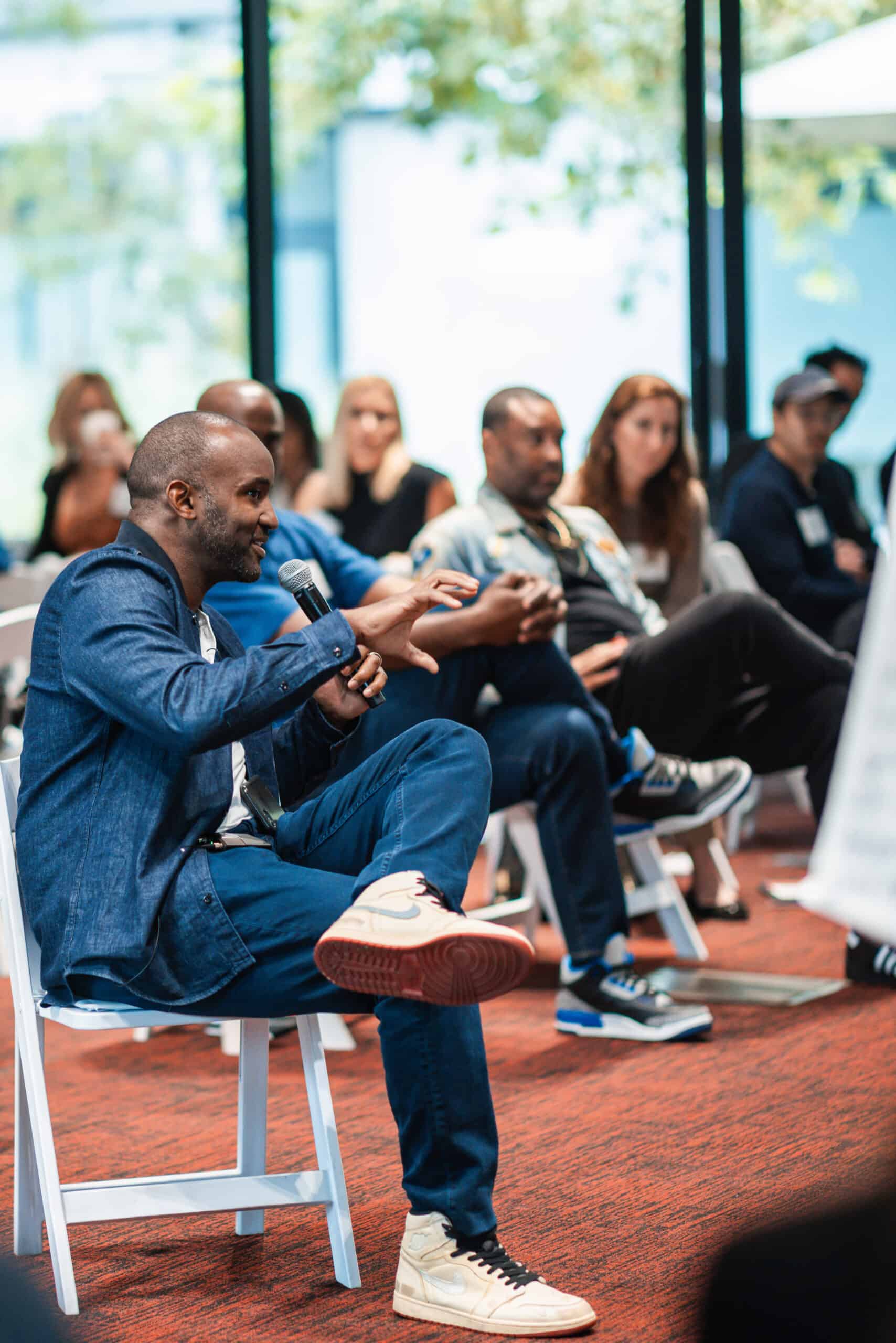
Kenny Mitchell, CMO, Snap, Inc
Mastering Now
If you were to fill up the Now Bucket with a list of your current strategies, they would most likely feel like old news, but they are delivering positive outcomes for your brand and business. Even though you’ve been doing these initiatives for a while, there is still room for mastery and optimization.
The “Now” category is a game of inches; winning is hard, it’s expensive, and it’s not easy breaking the model. As a marketer, you must think about how to hack it and optimize it into a process that does the work for you. Then you can spend more time looking at new innovative revenue streams that meet consumers where they are.
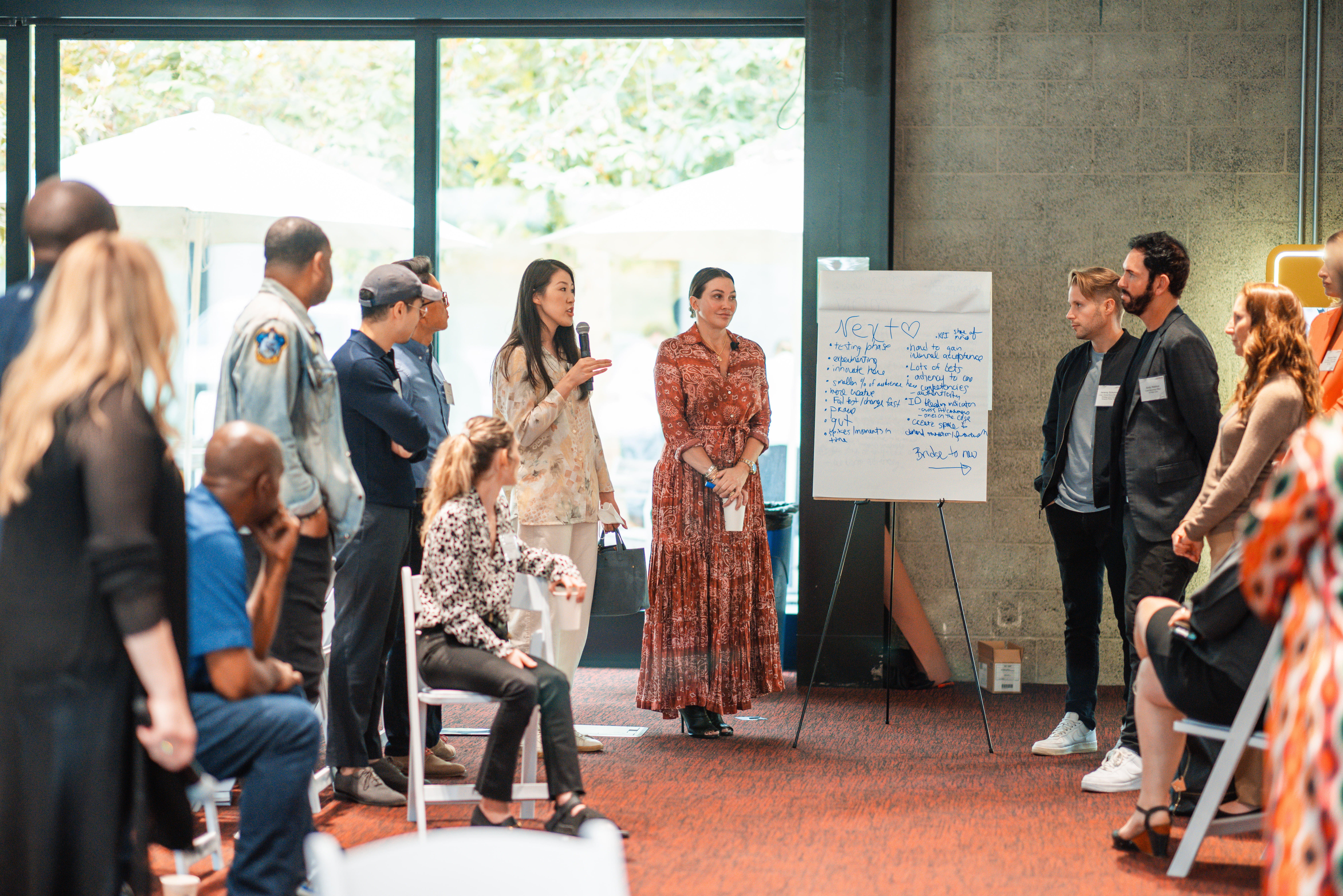
It’s important to consider that whether you’re an established brand or a growth brand, starting with user growth and developing the business’s core capabilities are essential for driving revenue today. There’s an urgency to build consumer attention; however, it’s difficult getting attention unless you’re connecting on multiple channels, getting familiarized with new technologies, and paying attention to trends to see how they emerge – it all matters.
In the Now, staying relevant through storytelling, creative content on social, and carving out differentiation in the digital and physical worlds is essential. To retain the community you’re building, they need to feel the relevancy.
The problem is that your brand could be relevant today and on the right channels, but the loyalty of the moment can dissolve in the snap of a finger. It’s crucial to always be prepared and build momentum so that you’re able to seamlessly move into what’s next.
Key Performance Indicator: Share of Wallet
Leaning into Next
If the Now is about core competencies, the Next is about going to the edges to maintain credibility, authenticity, and relevance. The challenge is that you have to be careful not to step so far outside the boundaries that your consumers question where you are going; this could put the brand identity at stake.
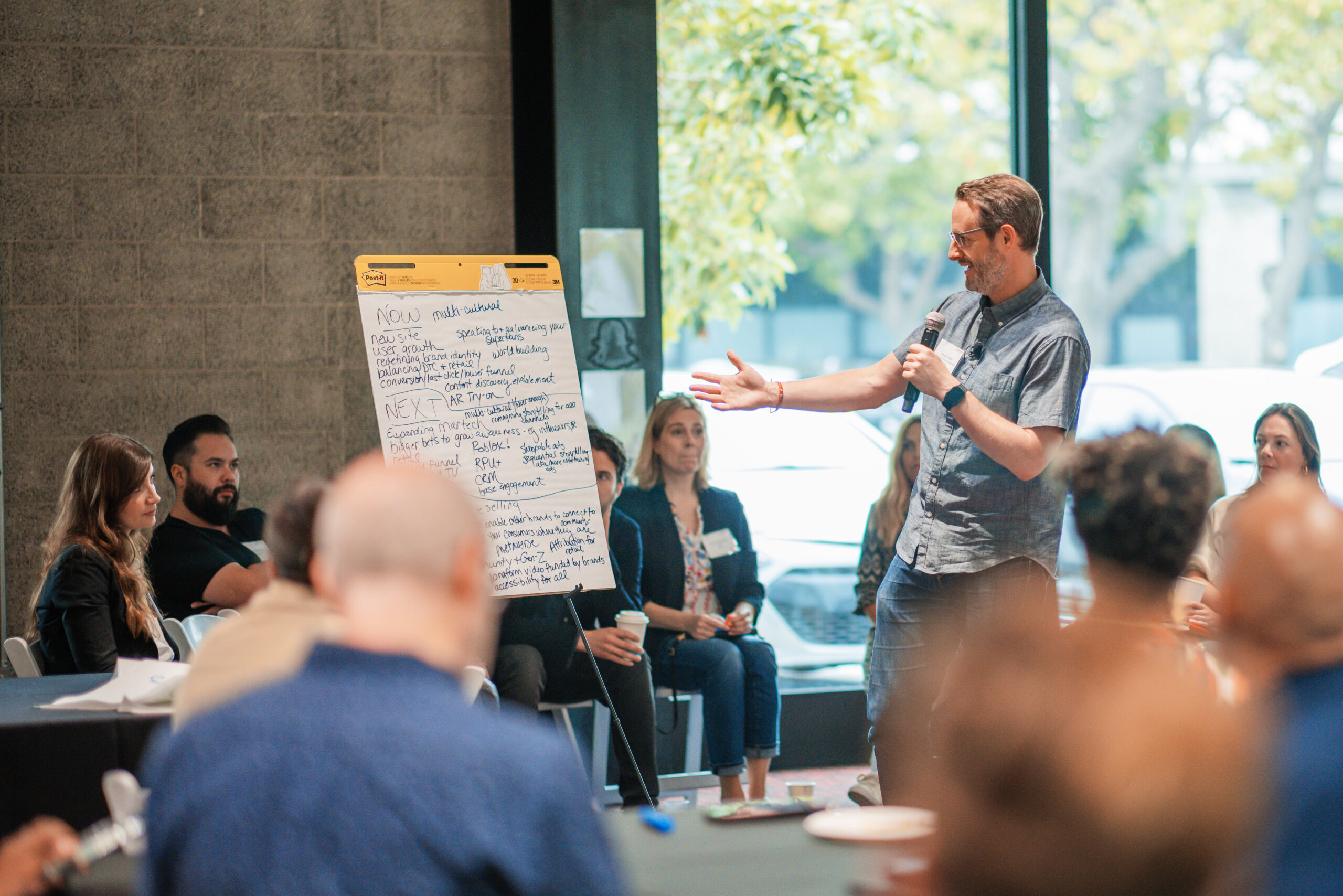
Doug Frisbie, VP, Global Business Marketing, Snap, Inc.
As Mike Cessario leads Liquid Death Mountain Water, an exciting challenger brand with the ambition to become an entertainment company, he shared that much of their success has come from daring to go where the market is telling them rather than assuming they know best. For him and his team, that looks like making small bets, analyzing what’s working, and leaning into that. One of their main focuses is leveraging media engagement as an investment with big ROI. Mike added, “We have to create something, and it has to be so incredibly interesting that people are generating media for us.”
Most brands are placing Metaverse in their next line of focus but are still testing and learning. As you track back to relevancy and aspire to build stakeholder trust, how you think about inspiration and motivation and set the hook will make all the difference. Even if you have the behavioral data to forecast trends, your facts checked, and you’re in line with big data and analytics, everything will fall flat if you don’t combine insights with emotion and relationship.
Listening with empathy, testing, and trusting your gut are vital components when leading your brand to the next strategy. For example, Kristin Patrick, the EVP and CMO of Claire’s stated in the panel, “How do you lead your brand through a complete turnaround and change the consumer’s perception of a completely analog business? Everyone has a sweet story about Claire’s, and that’s where I started – with the core of what the brand means to the consumers. Still, I have to do that and be on the bleeding edge of technology to connect with Gen Alpha and Gen Z.”
💡 Tip: From a cultural perspective, as you think about the audience you’re talking to, there must be a willingness to fail fast and change fast. As you venture beyond your core competencies, tapping on the shoulders of your brand evangelists can help get more people interested and engaged; they are a force of gravity that can help nurture stakeholders and help build the trust required to follow a new path.
Key Performance Indicator: Share of Time
Daring to Be New
Anytime you innovate from a brand perspective, it will be new to the consumer, internal teams, and direct reports. Going after the New is a gamble. Getting buy-in from all sides to believe in something that has the potential to win or flop takes immense courage, resilience, and trust.
Fabiola Torres commented “For a big company like PepsiCo, when it comes to massive distribution, fragmented channels, and new commodities, my mantra is, “how do we behave as a relevant, scrappy, personal startup? At the end of the day, consumers want different, distinctive relationships with brands…sometimes that means starting a product creation from scratch.”
Innovative products, content, entertainment, and experiences are under the spotlight for most brands. How can you pilot programs, initiatives, and offerings that reflect less like the traditional adoption curve and more like a shark fin? Being okay with pilots being digital forward and balancing IRL (in real life) versus URL (digital facing) experiences may be the first crack in the code for mastering the New category.
During the panel discussion, Angelic Vendette and Kenny Mitchell shared how they are thinking about enhancing IRL and URL experiences. Angelic stated, “Interestingly enough, when we think of New, we are working towards storefront experiences. We are a digital-first brand, and DTC has always been our model; this is new for our team members, and it’s new for the way we market to consumers.”
Snap is on a mission to use AR to enhance experiences. Kenny stated, “We’ve been thinking about getting Snap more connected to moments people love, like music, sports and culture, and then drive utility to make something fresh and new.”
💡 Tip: Whether you’re looking to launch a new product or thinking, you must consider counterintuitive thoughts. Fresh thinking and IP (Intellectual Property) can go a long way for a brand and excite many people. When it comes to bringing up new ideas internally and externally, there’s a correct time to do so, and it’s usually not at the end of the fiscal year. In terms of figuring out what is new, examine where your brand and consumers are on the adoption curve and know the leading and lagging indicators.
Key Performance Indicator: Share of Mind/Share of Search
Where Marketers Are Going
Throughout the MTM LA Forum, we asked marketing leaders from diverse categories to share what their current drivers of success are (Now), what they are seeing their audience shift (Next), and what they have on their radar (New). This model is not stagnant or fixed, but it ebbs and flows in response to your category, the culture, the lifecycle of your business, consumer trends, and more.
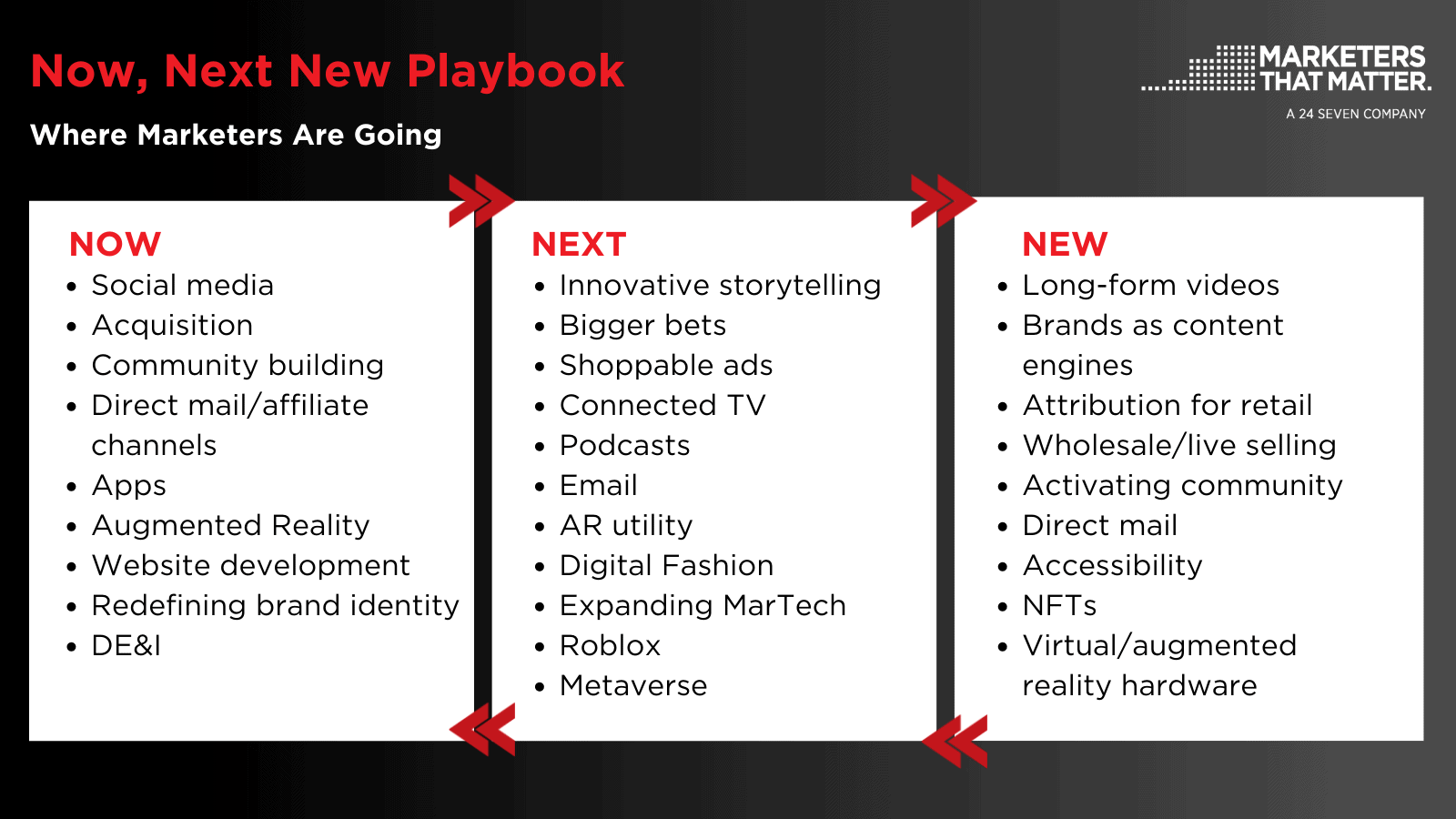
Now
Marketers are deep into social media, acquisition, membership and community building, direct mail/affiliate channels, apps, augmented reality, website development, redefining brand identity, and DE&I.
Next
Marketers are re-imagining storytelling, making bigger bets to grow awareness, shoppable ads, connected TV, podcasts, email, AR utility, digital fashion, metaverse, expanding MarTech, Roblox.
New
Marketers are dreaming about long-form videos, brands as content engines, attribution for retail, wholesale/live selling, activating community, direct mail (is hot again), accessibility for all, NFTs, and virtual/augmented reality hardware.
__________________________________________________
For more interactive experiences like this, Marketers That Matter has designed a new era of programming called The Marketing Boards. This is a 10-month program of facilitated small groups meeting together to collaborate and work through a curriculum of high-priority topics. Subscribe to our newsletter to stay updated!
About Kenny Mitchell, CMO, Snap, Inc.: Kenny Mitchell has a reputation for building iconic brands and driving industry-leading performance through innovative, fully-integrated, and award-winning marketing programs. Prior to joining Snap, Kenny led Brand Content & Engagement for McDonald’s USA and Consumer Engagement at Gatorade. Kenny has earned multiple Cannes Lions, film festival selections including Tribeca, and two Emmy nominations which led him to being recognized by Fast Company as one of the “Most Creative People in Business” in 2017.
Sadira Furlow, CMO, HappyMoney: As Chief Marketing Officer of Happy Money, Sadira Furlow is architecting growth and generating smiles across the consumer and partner landscape. Since joining the company in 2020, she has developed a customer-centric marketing strategy for long-term growth and has laid the brand’s foundation. Based on her extensive advertising and marketing experience, Sadira leads the Happy Money Marketing team toward greatness. She has a true hunger for growth, fueled by a love of the consumer and a passion for purpose, and has been recognized for her ability to shape how brands connect with consumers.
Following roles at well-known agencies such as Leo Burnett and Commonground, Sadira most recently led marketing for several iconic PepsiCo brands. She broke the internet with the ‘puppymonkeybaby’ campaign, oversaw the multi-billion-dollar Potato Chip portfolio, and led the highly successful launch of LIFEWTR. Among other accolades, she was named a 2020 Brand Genius by Adweek, one of AdAge’s Women to Watch, and one of Savoy’s Top Influential Women in Corporate America.
Fabiola Torres, CMO, Pepsi Energy: Fabiola is an experienced marketer with a creative, strategic mind. She is known for driving excellence and putting consumers first, with a digital mindset and holistic understanding of the brand and business. Her expertise is in consumer marketing and the execution of integrated and multichannel marketing. Before working at Pepsico, she worked at Apple for three years and at Nike for 18 years in Brand Marketing. Fabiola believes everything starts and ends with the consumer by developing a relationship with them through storytelling, social media, digital platforms, and community and then connecting them to the best product, services, and experiences. She is a virtual leader and mentor of diverse, multi-national teams, recognized for growing talent within the organization across functions.
Kristin Patrick, EVP and CMO, Claire’s: Kristin Patrick is a forward-thinking executive, who has been responsible for repositioning brands across lifestyle industries, including entertainment, beauty, fashion and CPG. She most recently served as the global CMO of PepsiCo, responsible for delivering the company’s long-term global growth strategy and expansion plans across the entire portfolio of brands. Prior to PepsiCo, she held leadership positions at renowned global brands, including as Chief Marketing Officer for Playboy Enterprises and at William Morris Endeavor, NBC Universal, The Walt Disney Company and Revlon, GAP Inc., Liz Claiborne’s Lucky Brand and Calvin Klein. Kristin joined Claire’s a little over a year ago as CMO to play a role in building on the fashion brand’s more than 50 years of leadership as a global creator and influencer of youth culture and to take the brand into the future.
Mike Cessario, Co-Founder & CEO, Liquid Death Mountain Water: Mike Cessario is the founder and CEO of Liquid Death, the fastest-growing nonalcoholic beverage brand. With a background as an advertising creative for industries like Crispin Porter & Bogusky, VaynerMedia, Humanaut, and more, his creative expertise led him to innovate a healthy, sustainable beverage as fun as energy drinks, beer, candy, and junk food.
Angélic Vendette, CMO, Alo Yoga: Angélic has been in the Marketing sectors of Fashion, Tech, Retail, and CPG for fifteen years. She has created award-winning campaigns on the brand, retailer, and agency sides of marketing. Curious and entrepreneurial at heart, she focuses on shaping conversations around the future of Retail, innovation, web3, emerging platforms, and sustainability. She leads highly successful teams and drives global marketing strategy at Alo Yoga, where inspiring mindful movement, wellness, and creating community is at the core of everything they do.
Marketers That Matter® is a community of top marketing executives coming together to pioneer the future of marketing, sharing real-time experiences, and solving current challenges.
Our parent company, 24 Seven, specializes in helping you find exceptional marketing and creative talent for your teams.
[/vc_column_text][/vc_column][/vc_row]

